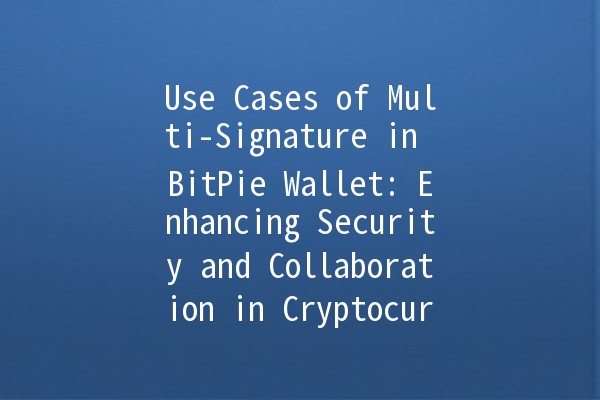
In the rapidly evolving world of digital currencies, security is paramount. Cryptocurrency wallets, such as the BitPie wallet, offer various features to protect assets, with multisignature (multisig) technology emerging as one of the most effective. This article explores the practical use cases of multisignature in the BitPie wallet, providing valuable insights and tips for users looking to enhance their security and collaboration.
Understanding MultiSignature Technology
What is MultiSignature?
Multisignature technology requires more than one private key to authorize a cryptocurrency transaction, providing an additional layer of security. Instead of relying on a single key, users can set up multiple keys, where a specified number of these must sign off on a transaction. This method not only protects against unauthorized access but also allows for collaborative control over funds.
How MultiSignature Works in BitPie Wallet

The BitPie wallet allows users to create multisig wallets easily. Users can define the number of keys required to authorize transactions (MofN), where M is the number of signatures needed, and N is the total number of potential signers. For example, a 2of3 multisig wallet means that out of three private keys, at least two must be used to approve a transaction.
Five Specific ProductivityEnhancing Techniques for Using MultiSignature in BitPie Wallet
Explanation:
A common use case for multisignature wallets in BitPie is shared control among team members. By creating a multisig wallet, organizations can ensure that multiple parties need to authorize transactions, preventing any single individual from having unilateral access.
Realworld Example:
A startup utilizes a 2of3 multisig wallet setup where three cofounders each possess a key. To make an expenditure, at least two cofounders must agree and sign the transaction, reducing the risk of impulsive spending and fostering collaborative decisionmaking.
Explanation:
Individuals can significantly enhance the security of their personal cryptocurrency holdings by employing multisig technology. Instead of keeping all keys on a single device, users can distribute keys across multiple devices or locations.
Realworld Example:
A user keeps one key on their smartphone, another on a hardware wallet, and the third key in a safety deposit box. This setup means that even if their smartphone is lost or hacked, their funds remain secure as at least two keys are necessary for a transaction.
Explanation:
Multisignature wallets are an effective tool for estate planning, allowing for the secure transfer of digital assets upon death or incapacitation. In this scenario, a multisig wallet can incorporate trusted family members or legal representatives as signers.
Realworld Example:
An individual sets up a 2of4 multisig wallet for their cryptocurrency assets, naming their spouse, two adult children, and their attorney as signers. In case of their passing, the wallet’s assets can only be accessed with the agreement of at least two signers, ensuring that the funds are distributed according to their wishes.
Explanation:
Organizations can use a multisig wallet to protect against internal fraud or mismanagement. By requiring multiple signatures from different department heads or financial officers, companies can ensure that funds are only spent with broad consensus.
Realworld Example:
A nonprofit organization establishes a multisig wallet requiring the signatures of the executive director, the treasurer, and an external auditor for any transaction above a certain amount. This setup minimizes the risk of misuse of funds by creating a checksandbalances system.
Explanation:
In decentralized finance, users often need to collaborate on transactions, governance, or liquidity pools. Multisignature wallets allow for secure collaboration without the need for trust between parties.
Realworld Example:
A group of investors uses a 3of5 multisig wallet to manage their investments in a DeFi project. Any decision regarding the allocation of funds or staking requires the majority consensus of the group, ensuring all members are involved in significant financial decisions.
By leveraging multisignature technology in the BitPie wallet, users can significantly enhance the security of their digital assets while also enabling productive collaboration among multiple parties. Whether for personal safety, organizational governance, or innovative DeFi applications, the practical applications of multisig are vast and varied.
Frequently Asked Questions
A multisig wallet is a type of cryptocurrency wallet that requires multiple signatures before a transaction can be executed. This can enhance security and control, as it prevents any single individual from having full access to the funds.
To set up a multisig wallet in BitPie, select the option during the wallet creation process, specify the number of required signatures, and distribute the private keys accordingly. Follow the app instructions to ensure correct setup.
BitPie wallets allow users to configure wallets with a flexible number of keys, ranging from 2 to 15 or more, depending on user requirements for security and collaborative access.
If you lose one of the keys, you may still be able to access the wallet, depending on your multisig configuration (MofN). For instance, in a 2of3 setup, losing one key wouldn’t prevent access, as only two signatures are required.
Modifying the configuration of a multisig wallet after its initial setup can be complex and may require creating a new wallet. It is advisable to plan your configuration carefully before establishing the wallet.
While multisig technology offers enhanced security, it may not be necessary for casual users or small amounts. However, for anyone managing significant funds or collaborating with others, it is a highly recommended practice for safeguarding assets.
Utilizing the multisignature feature of the BitPie wallet can provide unparalleled security and collaboration opportunities, making it a vital tool for anyone looking to enhance their cryptocurrency management practices.

